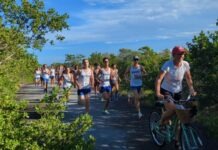
One hundred miles off the coast of Texas, the M/V Fling pulls up to a decommissioned oil rig. Tying off to its towering structure extending hundreds of feet underwater, a team of 32 focused divers descends past schools of sharks and jacks, dispersing across the sunken metal beams brimming with life.
Among those on the line: a pair of ER nurses and a police officer from Dallas, a Florida lawyer, an IT specialist from Colorado – and the Florida Keys’ own “lionfish queen,” Rachel Bowman.
The trip is the first of the season for the Lionfish Invitational, a trailblazing partnership meshing investigators from aquariums, universities, Texas Parks and Wildlife and NOAA with “civilian scientists.” (Read: Experienced divers who really, really love the ocean, want to make a difference and have decent aim with a pole spear.)
For three days, the team navigates their way through the reefs and rigs of the Flower Garden Banks National Marine Sanctuary (FGBNMS). Fitting in a laundry list of fish surveys and projects for scientists on board, the rest of the team has one goal: find as many invasive venomous lionfish as possible, and shoot them. (Don’t worry – they have a special permit.)
First detected more than 40 years ago as their invasion began in Florida, the visually stunning fish are native to the Indo-Pacific region. Their venomous spines pack a mean punch, and they’re a death sentence for millions of juvenile fish as they hoover up their meals on reef systems.
“When lionfish first invaded the sanctuary in 2011, we were really worried, because we thought they were going to take over the reef,” said FGBNMS superintendent Michelle Johnston. “We knew that we could not host traditional removal efforts like derbies that were being done in Florida – we can’t just let untrained people go 100 miles offshore and handle venomous fish and think that people are going to be safe and also follow the rules.
“We thought, ‘What if we bring skilled divers who are good at this, who are good hunters, and make it affordable, and do surveys and see if we’re having an impact?’ It started like that, as a test. We had an overwhelming response, it took off, and it became like a full-time job.”
Enter Bowman, widely regarded as a pioneer and leading expert in commercial lionfish collection from her home base in Marathon.
“Rachel literally harassed me and said ‘I’ve got to be on that boat,’” said Johnston. “She came the second year we started doing these (trips), and she just ran with it.”
Fast-forward a decade, and Bowman is president of the Lionfish Invitational, now its own nonprofit fielding more than 300 applications a summer just to grab a seat on one of four trips on the Fling.
For divers coming from just about anywhere else in the U.S., the experience is, in one participant’s words, like “diving on the moon.”
In the Keys, where a healthy reef could historically see 30 percent to 40 percent living coral cover, levels have dropped down to just 2%. Rope, abandoned “ghost traps” and severed anchors litter the bottom, exceedingly accessible at just three miles offshore.
At some dive sites within the Flower Garden Banks, look at the ocean floor, and living coral is all you’ll see.
“If you’re a coral person, the Flower Gardens are 100% on your bucket list,” said Bowman. “It’s one of the healthiest living coral reefs in America, and that’s their Everest.”
“What makes me so happy is people who’ve never seen it,” said Johnston. “When you see out here what a healthy reef system looks like, it changes you. It changes your understanding of the ocean.
“This is truly what a national marine sanctuary should be. It is special. It is worthy of protection. It’s worthy of your time and it’s worth you going home and being excited, talking about it and sharing.”
The experience on the 100-foot Fling, operated by Texas Caribbean Charters as one of the only commercial opportunities to dive the Flower Gardens, is “lionfish summer camp on the water,” in both women’s words. Up to four dives per day are separated by healthy two-hour surface intervals, during which the crew of the vessel – most of whom volunteer their time – keep bellies full and minds clear in preparation for the next sub-sea venture.
“The care and service you get from every employee – they make you feel like you’re the only person on the boat,” said Bowman. “You want for nothing, and they are so insanely helpful and they’re so glad we’re out there doing what we’re doing.”
But the trip is, at its core, a research expedition for the good of the reef, a factor never lost beneath the camaraderie of those on board.
After each dive, harvested fish are individually measured, with fins clipped for genetic and toxin analysis. Science teams on board coordinate their individual needs and objectives for ongoing studies at each dive site, from collections of other invasive fish to water sampling, monitoring of buoy lines and replacements of acoustic tag receivers on the reefs.
“I think it’s one of the most impactful things we do, both research-wise and education-wise,” said Johnston. “To get people to care about a place that is 100 miles offshore that they most likely will never see is a challenge for us. It’s a broad range of people who get exposed to this, take it back to where they’re from, and then it’s like a ripple effect.”
And while much more thorough studies are needed, the eye test says the team’s efforts are making a dent.
In the early years targeting the species, removal efforts, including Lionfish Invitational cruises, could eliminate 300 to 400 fish at a time. In August 2018, that number soared to near 800 on an all-rigs expedition.
But on the first trip of 2025, divers found and removed just 99 fish. That could be a good thing, but it’s too early to make the final call.
“It’s the typical boom and bust of invasive species,” said Johnston. “You’ll have your initial boom, and then it drops off. And so a key question for me is, are we going to have a boom again?”
“It pretty much goes with the rest of the numbers in the rest of the Gulf and Florida,” Bowman added, comparing trips in the Flower Gardens to her commercial harvests from 2016 to 2019.
A lack of natural predators has aided the spread of the spiny fish across the Caribbean and into the Gulf. But now, there are even signs that human hunters may be getting assistance from their natural counterparts.
Recently, a lionfish marked at a Flower Garden Banks reef with an acoustic tag by Texas A&M University investigator Marissa Nuttall pinged at a nearby oil rig – and a special device designed to interact with the stomach acid of a predator if the fish was consumed was triggered.
“My hope is that, with us going out and doing our job, we might not ever have an uptick like this again, which is one less thing the reef system has to worry about,” said Johnston.
“As you decrease the staff of the agencies that conduct this research, people such as myself are obligated to step up and fill that void,” said Bowman. “There is still research to be done. We’re just not going to get paid to do it, but it’s going to still happen.”
More information, including applications for divers who have their Advanced Open Water and Enriched Air certifications, is at lionfishinvitational.com. The nonprofit is always accepting donations, and as Bowman said with a laugh, “You can 100% buy your way onto this boat.” To support research and operations within the FGBNMS, visit marinesanctuary.donorsupport.co/page/FGBNMS.


























